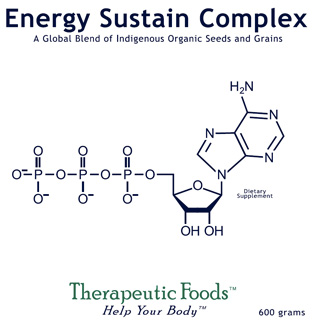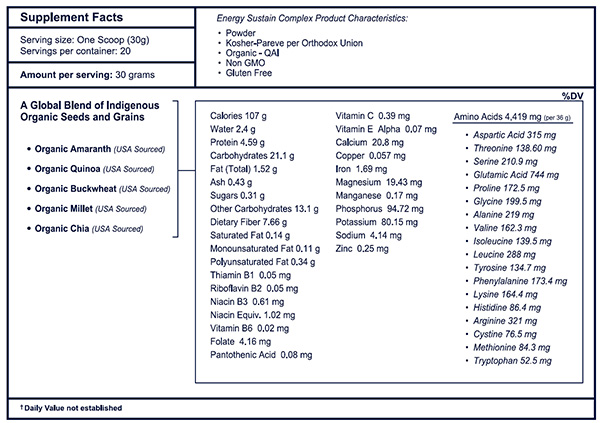The Energy Sustain Complex
|
Dear Friends,  
On Monday this week I presented in our newsletter to you our new Ultra Minerals- Mesozoic Vegetate. In case you missed the email you can find it on our website under the Publishing Blog tab or through this link—Forward Thinking October 31st. Check it out, it’s quite good, I think you’ll like it. Today, as I promised, I’m presenting the second of our new products—Energy Sustain Complex– A Global Blend of Indigenous Seeds and Grains. Whereas the plant sourced minerals for our Ultra Minerals come from Deep Time (dinosaur era) vegetate (see the Green Facts at the end of this email), Energy Sustain Complex is a mix of indigenous organic seed and grains from different parts of the world. The formula is comprised of foundational foods that have been with us for thousands of years, and are a very important part of our evolutionary history. Their benefits are well documented and researched. The Energy Sustain plant based materials come from USA organically grown amaranth, buckwheat, chia, quinoa and millet— the first four being true seeds and millet being a true grain. The Energy Sustain Complex: Science and Attributes  Millet may be the oldest, having been dated back to as early as 8300 BC in China and Korea. Millet is very rich in B vitamins, especially niacin, B6 and folic acid, and essential minerals such as calcium iron, potassium, magnesium and zinc. The Hunzas, who live in a remote area of the Himalayan foothills and are known for their excellent health and longevity, enjoy millet as a staple in their diet. Millet is highly nutritious, non-glutinous, and like buckwheat and quinoa, is not an acid forming food, therefore soothing and easy to digest. In fact, it is considered to be one of the least allergenic and most digestible grains available, a warming grain to help heat the body in cold or rainy seasons. It is nearly 15% protein, contains high amounts of fiber, B-complex vitamins including niacin, thiamin, and riboflavin, the essential amino acid methionine, lecithin, and some vitamin E. It is particularly high in the minerals iron, magnesium, phosphorous, and potassium. The seeds are also rich in phytochemicals, including phytic acid, which is believed to lower cholesterol, and phytate, which is associated with reduced cancer risk.  Amaranth was domesticated in Mexico as early as 7000 BC. Early Aztecs used it both for food and in their religious ceremonies. The name amaranth hails from the Greek for “never-fading flower.” The plant is an annual herb, categorized as a seed, and is a relative of a common wild plant also known as lamb’s-quarters. Amaranth has exceptional nutritional value for humans due to its ease of digestion, 12% overall protein content and unusually high content of lycine and methionine, two essential amino acids that are frequently not found in grains. The fiber content of amaranth is three times that of wheat, while its iron content is five times more than wheat. Amaranth also contains calcium, potassium, phosphorous and Vitamin A and C. It offers two times more calcium than milk. Amaranth supplies tocotrienols (a form of vitamin E) which have cholesterol-lowering activity in humans. Cooked amaranth is 90% digestible and because of this ease of digestion, it has traditionally been given to those recovering from an illness or ending a fasting period.  Buckwheat origin is in Southeast Asia, likely from around 6000 BC. From there its use gradually spread to the Middle East and Europe. Buckwheat is a fruit seed that is related to rhubarb and sorrel. Diets that contain Buckwheat have been linked to lowered risk of developing high cholesterol and high blood pressure. The Yi people of China consume a diet high in Buckwheat (100grams per day). When researchers tested blood lipids of 805 Yi Chinese, they found that buckwheat intake was associated with lower total serum cholesterol, lower low-density lipoprotein cholesterol (LDL-the form linked to cardiovascular disease), and a high ratio of HDL (health-promoting cholesterol) to total cholesterol. Buckwheat’s beneficial effects are due in part to its rich supply of flavonoids, particularly rutin. The nutrients in buckwheat may contribute to blood sugar control. In a test that compared the effect on blood sugar of whole buckwheat groats to bread made from refined wheat flour, buckwheat groats significantly lowered blood glucose and insulin responses. Buckwheat also contains almost 86 milligrams of magnesium in a one-cup serving. Magnesium relaxes blood vessels, improving blood flow and nutrient delivery while lowering blood pressure-the perfect combination for a healthy cardiovascular system. Whole buckwheats also scored highest on their ability to satisfy hunger. Buckwheat is an excellent source of lysine, threonine, tryptophan and sulfur containing amino acids. It contains up to 37% resistant starch. Its glycemic index is 45.  Quinoa has been cultivated in South American Andes since at least 3,000 B.C. and has been a staple food of millions of native inhabitants. The ancient Incas called quinoa the “mother grain,” and revered it as sacred. Quinoa was used to sustain Incan armies, which frequently marched for many days eating a mixture of quinoa and fat. Technically, quinoa is not a true grain, but is the seed of the Chenopodium or Goosefoot plant. Quinoa supplies a uniquely balanced set of essential amino acids and is one of the best sources of plant-based proteins. It contains an almost perfect balance of all eight essential amino acids needed for tissue development in humans. It is exceptionally high in lysine, cystine and methionine-amino acids typically low in other grains. The quinoa seed is also high in calcium and iron, a relatively good source of vitamin E and several of the B vitamins. It is a high iron food that raises the hematocrit, delivering more oxygen to the brain to fight senility. Quinoa is an alkaline food, easy to digest, and provides important dietary fiber. Quinoa is 35 on the Glycemic Index (very low!).
Chia, like amaranth, was also very important to the ancient Aztecs of 7000 BC. Chia seed is a magical whole food, so much so that it was once valued as currency. It was known as the “running food.” Its use as a high energy endurance food has been recorded as far back as the Aztecs of old. The Aztec warriors subsisted primarily on Chia seeds during their conquests. The Indians of the southwest would eat as little as a teaspoon full when going on a 24 hour forced march. Indians running from the Colorado River to the California coast to trade turquoise for seas shells would only bring Chia seed for their nourishment. Chia’s soluble fiber is highly mucilaginous and forms a gel in the stomach and intestines, slowing down absorption of glucose. The glycemic index of chia is 1—ONE. With Chia seeds, our body regulate more efficiently the absorption of nutrients. Because there is a greater efficiency in the utilization of body fluids, the electrolyte balance is maintained. Chia seeds can contain up to 20% protein, 25% dietary fiber, unusually high levels of healthy ormega-3 fatty acids, and significant levels of antioxidants. Seann Bardell Clinical Note: Energy Sustain Complex is a great drink in the morning or any time of the day. Mix it with juice—we love to mix it with pomegranate juice and coconut water, and in the hot days of summer, with watermelon juice, but any juice or soy or nut milk will work beautifully with the Energy Sustain. We add the Original Synbiotic, Beta Glucan Synbiotic, or the Triple Berry Probiotic for a good boost of bugs and fiber. At times we add rice protein or goat yogurt, or soy/nut/coconut yogurt for added protein although the complex has a nice amount to keep our bodies humming. You can add fruit… it is delicious no matter what you add to it, and of course, very foundational to our health. The Energy Sustain Complex provides an excellent compliment of macronutrients—complex carbohydrate, fiber and protein. Glucose is our body’s preferred molecule for ATP production. One glucose molecule can produce 38 ATP molecules for pure energy. The key with carbo-hydrate is the rate of flow from the gut into the blood stream and this is monitored by what is called the glycemic load. The beauty of Energy Sustain is that you can vary the energy flow into body by simply letting the mixture sit in water or any liquid for a length of time. If you want a quick energy hit then drink it right away after mixing with liquid—the glycemic index would be around 69. If you want a long lasting more modulated infusion of energy then allow the powder to sit in your liquid drink from a few minutes. The longer you let it sit the lower the glycemic index goes. This is do to the soluble fiber is the seeds and millet that have been concentrated through the manufactring process. The chia in particular is very mucilagenous and enhances viscosity when allowed to sit, driving down the glycemic index. Through a patented thermo-mechanical process the endosperm tissues of these seeds and grain are disrupted allowing for the removal of the cellulosic fibers by filtration and centrifugation procedures. During this hydrocolloid process the seeds and grain nutrients are rendered more bioavailable. This process renders the powder into a wonderfully misible homegenous drink when added to your water, smoothy, green drink, etc. You will really like this product. 
The Last Quiz Answer: “Polar bears are intriguing to watch. Each has his or her own personality—just like humans,” said Robert Buchanan of Polar Bears International, a non-profit organization dedicated to the worldwide conservation of the polar bear. “Some bears are shy, some are playful, while others are grouchy or aggressive.” There are 20,000 to 25,000 polar bears around the world. They are the world’s largest carnivore. Polar bears top the food chain in the Artic, and people view them as a majestic symbol of the far north. Here is a sweat little video of polar bears and dogs playing—a playful 1500 lb. hug.
|



